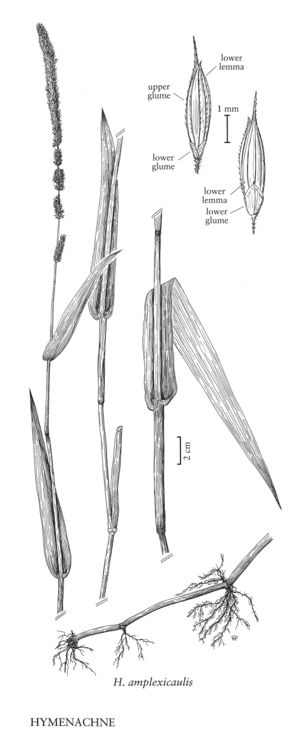| Taxon | Illustrator ⠉ | |
|---|---|---|
 | Hymenachne amplexicaulis | Hana Pazdírková Linda A. Vorobik |
Plants perennial. Culms 50-350 cm, decumbent, often rooting from the lower nodes; nodes glabrous; internodes glabrous, filled with spongy aerenchyma. Leaves evenly distributed; ligules membranous. Inflorescences narrow, condensed, cylindrical or spikelike panicles; branches appressed but not fused to the rachises, densely and evenly short ciliate on the ridges. Spikelets dorsally compressed, narrowly lanceolate, with 2 florets. Glumes unequal, membranous, with a definite rachilla internode between the 2 glumes; lower glumes no more than 1/2 as long as the spikelet, 1-3-veined; upper glumes subequal to or longer than the lower lemmas, membranous, not saccate, 3-7-veined; lower florets sterile; lower lemmas similar to the upper glumes; upper florets bisexual, much shorter than the upper glumes and lower lemmas; upper lemmas membranous to leathery, white at maturity, margins clasping the edges of the paleas basally but not distally, apices acute; paleas similar in texture to the lemmas; lodicules 2; anthers 3; styles 2, fused. Caryopses falling free from the lemmas and paleas. x = 10.
Distribution
Puerto Rico, Fla.
Discussion
Hymenachne is a pantropical genus of approximately five species. It is unusual in the Paniceae in that all its members grow in aquatic or swampy habitats. It differs from Sacciolepis in its aerenchyma-filled internodes, a character that is probably an adaptation to its aquatic habitat. One species is native to the Flora region.
Selected References
Lower Taxa
"decumbent" is not a number.